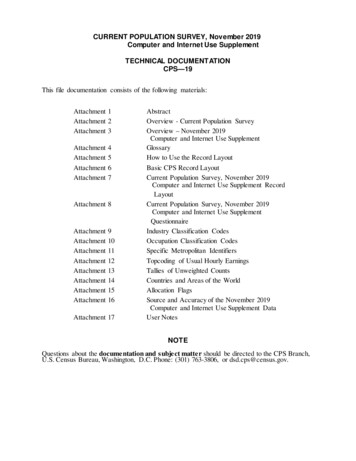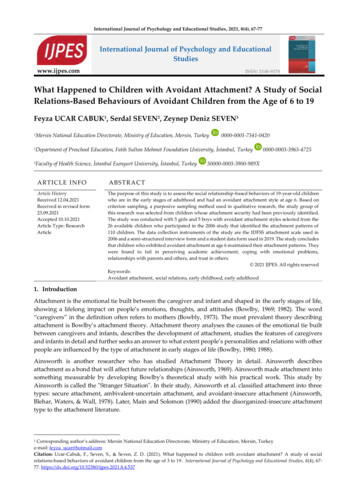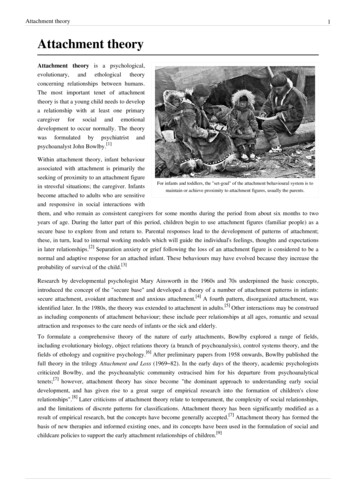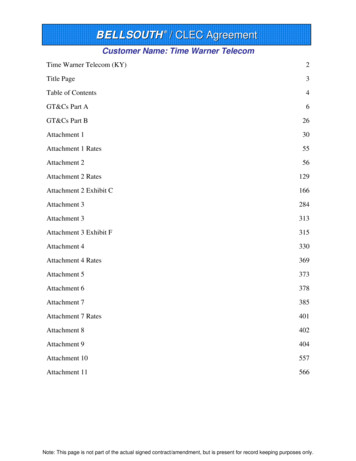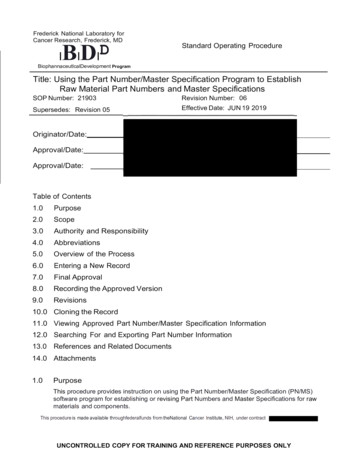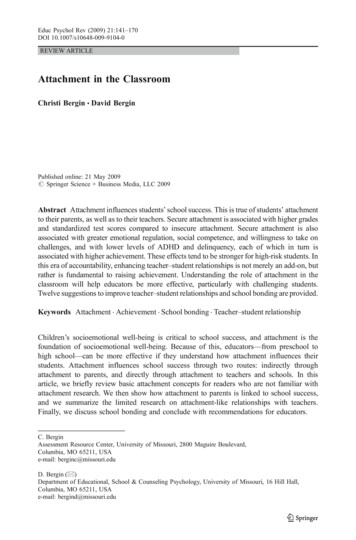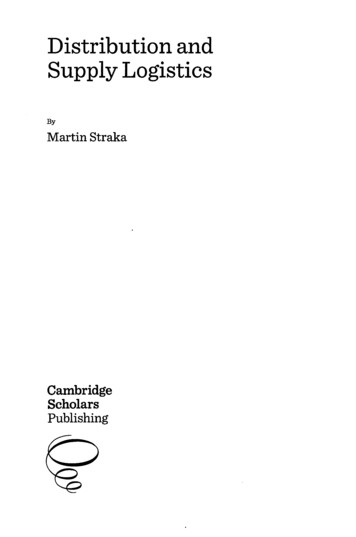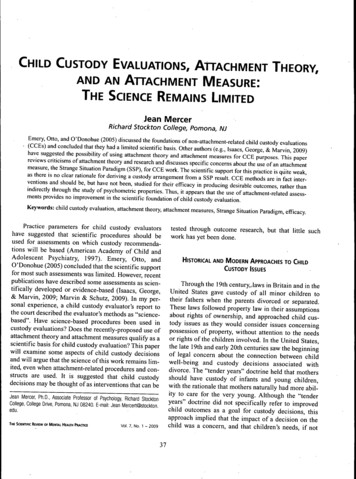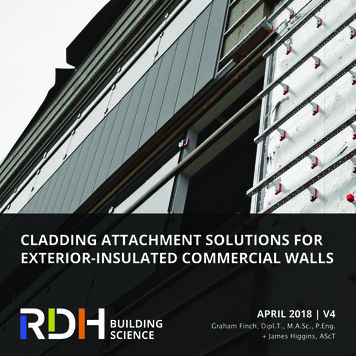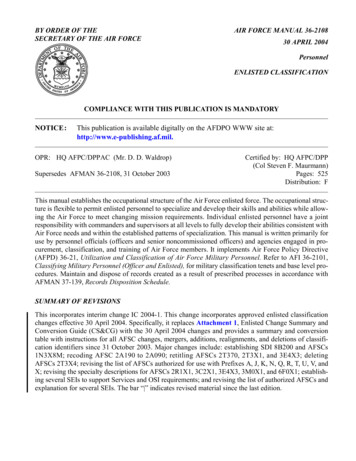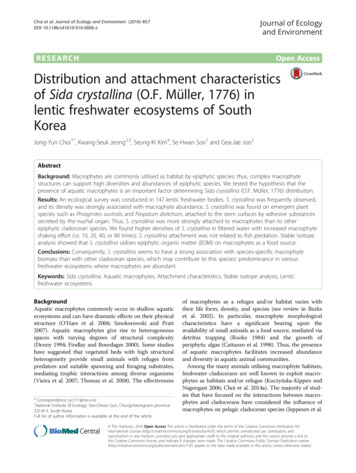
Transcription
Choi et al. Journal of Ecology and Environment (2016) 40:7DOI 10.1186/s41610-016-0006-zJournal of Ecologyand EnvironmentRESEARCHOpen AccessDistribution and attachment characteristicsof Sida crystallina (O.F. Müller, 1776) inlentic freshwater ecosystems of SouthKoreaJong-Yun Choi1*, Kwang-Seuk Jeong2,3, Seong-Ki Kim4, Se-Hwan Son1 and Gea-Jae Joo2AbstractBackground: Macrophytes are commonly utilised as habitat by epiphytic species; thus, complex macrophytestructures can support high diversities and abundances of epiphytic species. We tested the hypothesis that thepresence of aquatic macrophytes is an important factor determining Sida crystallina (O.F. Müller, 1776) distribution.Results: An ecological survey was conducted in 147 lentic freshwater bodies. S. crystallina was frequently observed,and its density was strongly associated with macrophyte abundance. S. crystallina was found on emergent plantspecies such as Phragmites australis and Paspalum distichum, attached to the stem surfaces by adhesive substancessecreted by the nuchal organ. Thus, S. crystallina was more strongly attached to macrophytes than to otherepiphytic cladoceran species. We found higher densities of S. crystallina in filtered water with increased macrophyteshaking effort (i.e. 10, 20, 40, or 80 times). S. crystallina attachment was not related to fish predation. Stable isotopeanalysis showed that S. crystallina utilises epiphytic organic matter (EOM) on macrophytes as a food source.Conclusions: Consequently, S. crystallina seems to have a strong association with species-specific macrophytebiomass than with other cladoceran species, which may contribute to this species’ predominance in variousfreshwater ecosystems where macrophytes are abundant.Keywords: Sida crystallina, Aquatic macrophytes, Attachment characteristics, Stable isotope analysis, Lenticfreshwater ecosystemsBackgroundAquatic macrophytes commonly occur in shallow aquaticecosystems and can have dramatic effects on their physicalstructure (O’Hare et al. 2006; Smokorowski and Pratt2007). Aquatic macrophytes give rise to heterogeneousspaces with varying degrees of structural complexity(Denny 1994; Findlay and Bourdages 2000). Some studieshave suggested that vegetated beds with high structuralheterogeneity provide small animals with refuges frompredators and suitable spawning and foraging substrates,mediating trophic interactions among diverse organisms(Vieira et al. 2007; Thomaz et al. 2008). The effectiveness* Correspondence: jyc311@nie.re.kr1National Institute of Ecology, Seo-Cheon Gun, Chungcheongnam province325-813, South KoreaFull list of author information is available at the end of the articleof macrophytes as a refuges and/or habitat varies withtheir life form, density, and species (see review in Burkset al. 2002). In particular, macrophyte morphologicalcharacteristics have a significant bearing upon theavailability of small animals as a food source, mediated viadetritus trapping (Rooke 1984) and the growth ofperiphytic algae (Cattaneo et al. 1998). Thus, the presenceof aquatic macrophytes facilitates increased abundanceand diversity in aquatic animal communities.Among the many animals utilising macrophyte habitats,freshwater cladocerans are well known to exploit macrophytes as habitats and/or refuges (Kuczyńska-Kippen andNagengast 2006; Choi et al. 2014a). The majority of studies that have focused on the interactions between macrophytes and cladocerans have considered the influence ofmacrophytes on pelagic cladoceran species (Jeppesen et al. The Author(s). 2016 Open Access This article is distributed under the terms of the Creative Commons Attribution 4.0International License (http://creativecommons.org/licenses/by/4.0/), which permits unrestricted use, distribution, andreproduction in any medium, provided you give appropriate credit to the original author(s) and the source, provide a link tothe Creative Commons license, and indicate if changes were made. The Creative Commons Public Domain Dedication o/1.0/) applies to the data made available in this article, unless otherwise stated.
Choi et al. Journal of Ecology and Environment (2016) 40:71998; Meerhoff et al. 2007). These studies argued thataquatic macrophytes are capable of providing suitablehabitats for mainly pelagic cladocerans. However, pelagicspecies are continuously exposed to predators such as fishdue to their frequent movement; thus, it would be relatively difficult for such pelagic species to develop higherabundances in freshwater ecosystems. In comparison withother aquatic systems, shallow wetlands are characterisedby abundant aquatic macrophytes, and this abundance ofhabitat tends to attract more cladoceran species. Theseare known as epiphytic cladocerans (i.e. plant-attachedspecies; Castilho-Noll et al. 2010; Gyllström et al. 2005;Kuczyńska-Kippen and Nagengast 2006) and are stronglyaffected by the abundance, morphology, and arrangementof plant species (Choi et al. 2014b). Unfortunately,epiphytic cladoceran distribution patterns and modes ofmacrophyte utilisation are still unclear, and their abundances are usually underestimated.Sida crystallina (Cladocera: Sididae, O.F. Müller 1776)is a typical epiphytic cladoceran species occurring intemperate and tropical waters. They attach to aquaticmacrophytes by means of maxillary glands and thus filterfeed in fixed positions (Fairchild 1981). Compared withother cladoceran species, S. crystallina occurs at relativelyhigh water temperatures (approximately 21 to 22 C;Kotov and Boikova 1998) and is prevalent in temperatezones during summer (Balayla and Moss 2003). They arefound in most shallow freshwater ecosystems in SouthKorea during summer (Choi et al. 2014c). Unfortunately,although the overall distribution of the species has beenreported (Downing and Peters 1980; Lauridsen et al.1996), its distribution patterns, attachment characteristics,and feeding habits have been insufficiently studied.In this study, we investigated the distribution patterns ofS. crystallina in lentic freshwater ecosystems in SouthKorea. We hypothesised that S. crystallina may prefershallow wetland microhabitats in which macrophytesdominate and may utilise epiphytic algae growing onmacrophyte stands as their food source. To test thesehypotheses, we investigated (i) the influence of diversephysicochemical parameters and macrophytes on S.crystallina distribution and (ii) the nature of attachmentof S. crystallina in relation to fish predation and foodavailability. We surveyed 147 lentic ecosystems in SouthKorea and recorded physicochemical parameters of water,macrophyte occurrence, and S. crystallina densities.MethodsStudy sitesSouth Korea is located in East Asia and has a temperateclimate. Four distinct seasons lead to the dynamicsuccession of biological communities in the freshwaterecosystems of South Korea. Annual mean rainfall is ca.1150 mm, more than 60 % of which occurs from June toPage 2 of 10early September (Choi et al. 2011; Jeong et al. 2007). Ourstudy sites were located in south-eastern South Korea,along the middle and lower reaches of the Nakdong River.Historically, there were numerous riverine wetlands in thisriver basin (Son and Jeon 2002); however, large areas ofwetland have vanished due to the expansion of humansociety (Burkett and Kusler 2000). The dominant landcover surrounding reservoirs is agricultural, and nonpoint source pollution continuously influences the studysites (Korean Ministry of Environment 2006).We investigated 147 lentic freshwater ecosystems in theriver basin (wetlands, ponds, and reservoirs; see Fig. 1).The wetlands and shallow lakes are dominated by variousmacrophyte species; however, the development andgrowth of macrophytes is inhibited in reservoirs and somelakes due to their impermeable floors. In addition, somewetlands support only a few plant species because of highwater levels and low nutrient concentrations. Therefore,the study sites encompassed a wide range of microhabitatcharacteristics (i.e. different types of lentic systems anddifferent patterns in their constituent plant communities).Monitoring strategyThe target species S. crystallina is known to preferrelatively high water temperatures (approximately 21 to22 C; Kotov and Boikova 1998) and is prevalent intemperate zones during summer (Balayla and Moss 2003).Based on this information, we monitored study sites insummer (June to July 2012). At each site, three samplingpoints were established in the littoral zone.Physicochemical parameters were measured and S.crystalline collected at each sampling point. Watertemperature, dissolved oxygen, conductivity, pH, chlorophyll a, and turbidity were measured at each site. Watersamples were collected at a depth of 0.5 m. We used a DOmeter (YSI DO meter; Model 58, YSI Research Inc., OH,USA) to measure water temperature and dissolved oxygen.Conductivity and pH were measured using a conductivitymeter (YSI Model 152; Yellow Springs Instruments,Yellow Springs, OH, USA) and pH meter (Orion Model250A; Orion Research Inc., Boston, MA, USA). Turbidityand chlorophyll a concentration were measured in thelaboratory. Turbidity was measured using a turbidimeter(Model 100B; Scientific Inc., Ft. Myers, FL, USA). Thewater samples were filtered through mixed celluloseester (MCE) membrane filters (Advantech; Model No.,A045A047A; pore size, 0.45 μm), and chlorophyll aconcentration was ascertained based on the methodologyof Wetzel and Likens (2000).At each sampling point, we took an additional 10 L ofwater for zooplankton collection from the surface layer(to a depth of 0.5 m), using a 10-L column sampler. Thiswater was filtered through a plankton net (68-μm meshsize), and the filtrate was preserved in sugar formalin
Choi et al. Journal of Ecology and Environment (2016) 40:7Page 3 of 10Fig. 1 Map of the study area in south-eastern South Korea. The study sites are indicated as solid circles. The small map in the upper right cornershows the Korean Peninsula(final concentration 4 % in the form of aldehyde). S.crystallina and other zooplankton species were identifiedand counted using a microscope (ZEISS, Model Axioskop40; 200 magnification) using the classification key ofMizuno and Takahashi (1991).To investigate attachment characteristics of S. crystallina,we additionally collected S. crystallina from stems andleaves of macrophytes at six sites where high abundances ofS. crystallina were observed. We established five quadrats(0.5 m 0.5 m) along the littoral zone at each of these sitesand counted all S. crystallina within each quadrat. We didnot include emergent organs of macrophytes above thewater surface (i.e. stalks and flowers) because S. crystallinainhabit underwater environments. The submerged partswere handled carefully to prevent S. crystallina fromaccidentally detaching. S. crystallina were kept alive usingfiltered wetland water. Small animals including zooplanktonwere removed from 2 L of water using a plankton net(32 μm mesh size), and the filtered water was stored in 5-Ltanks. This water was used as temporary storage forepiphytic species including S. crystallina. Collected macrophytes were shaken in the tank to detach S. crystallina(for the detaching process, see Sakuma et al. 2002). S.crystallina on the plants were detached by shaking 10,20, 40, and 80 times. After collection of S. crystallina atthe study sites, macrophyte samples were carried to thelaboratory and dried at 60 C for 2 days. Epiphyticspecies, including S. crystallina, were filtered from thewater using a 68 μm mesh net and immediately fixed withsugar formalin (final concentration 4 % in the form ofaldehyde). We counted numbers of S. crystallina using amicroscope (ZEISS, Model Axioskop 40; 200 magnification). Densities of S. crystallina attached to plants wereexpressed as number of individuals per gramme dryweight of macrophyte (ind. g 1 dw).Microcosm experimentTo understand how the attachment characteristics of S.crystallina influence fish predation, we conductedadditional microcosm experiments. Approximately 200S. crystallina adult individuals with similar life-historytraits (body size and condition of clutch) were selected.These S. crystallina individuals were acclimatised forapproximately 48 h in a stock culture environment
Choi et al. Journal of Ecology and Environment (2016) 40:7(Elendt M4 medium; Elendt 1990). To simulate the fishpredation, we used fish chemical cues (De Meester andCousyn 1997) in this microcosm experiment. A total offive fish species were considered, Micropterus salmoides(Lacepéde 1802), Lepomis macrochirus (Rafinesque1819), Pseudorasbora parva (Temminck and Schlegel1846), Rhinogobius brunneus (Temminck and Schlegel1845), and Misgurnus anguillicaudatus (Cantor 1842).We collected samples of these fish at the study siteswhere we obtained S. crystallina using a 7 mm 7 mmcast net and a 5 mm 5 mm scoop net. To obtain fishchemical cues from the collected fish, we allocated eachfish species to one of five tanks, and five individuals ofeach fish species were acclimatised in each tank for 24 h(tanks filled with 10 L Elendt M4 medium).The experiment was designed as follows: a total of sixgroups—control (no predation) and five experimentalgroups by using each of the fish species. First, we prepared60 500-mL beakers (10 beakers per experimental group)and filled each with 300 mL of clear M4 medium. We putfive S. crystallina individuals in each beaker and allowedthem to acclimatise to the new environment for 30 min.During the acclimatisation period, we prepared the fishchemical cues used in the experiment: the fish-exposedM4 medium was filtered using a 30 μm mesh net (usedonly in this experiment and not used for field planktoncollection) to remove particulate matter. Before introducing the resulting fish chemical cues to the experimentalbeakers, we very carefully marked the position of each S.crystallina individual on the outer surface of every beaker.Then, we injected 200 mL of fish chemical cue into eachbeaker. For the control group, unexposed, clear M4medium was added. The S. crystallina individuals wereallowed to respond to the changed environment for30 min, and then, we investigated the number of movedindividuals.Data analysisWe used two-way ANOVA (α 0.05) to analyse how thedensity of S. crystallina varied with shaking procedure (i.e.10, 20, 40, and 80 times) and collection site. Differences inS. crystallina movement among fish predation treatmentswere analysed statistically using one-way ANOVA. Furthermore, the relationships between S. crystallina densityand environmental variables were tested using stepwisemultiple regression. All statistical analyses, including stepwise multiple regression and ANOVA, were conductedusing the statistical package SPSS for Windows ver. 14.Stable isotope analysisStable isotope analysis was conducted to identify the foodsources of S. crystallina. Particulate organic matter (POM),epiphytic organic matter (EOM), and S. crystallina individuals were sampled at six different sites where S. crystallinaPage 4 of 10was abundant. To process the POM samples, any smallanimals were first removed using a plankton net(32 μm mesh size), and then, the water samples were filtered through GF/F glass-fibre (pre-combusted at 500 Cfor 2 h). The surfaces of submerged parts of macrophytesfrom each study point were gently brushed in a tank filledwith distilled water, in order to obtain the EOM. Similar tothe processing of POM, micro- and macroinvertebrateswere removed using the plankton net (32 μm mesh size). S.crystallina individuals were isolated using a micropipette.POM and EOM samples were treated with 1 N HCl toremove inorganic carbon and rinsed with distilled waterto remove the acid. S. crystallina samples were notacidified to remove inorganic carbon, because acidificationaffects nitrogen values (Pinnegar and Polunin, 1999). Allsamples were freeze-dried and homogenised with a mortarand pestle, and the powdered samples were kept frozen( 70 C) until analysis. Carbon and nitrogen isotope ratioswere determined using continuous-flow isotope massspectrometry. Dried samples (ca. 1 mg for S. crystallinasamples and 1.5 mg for POM and EOM) were combustedin an elemental analyser (Euro EA 3000 ElementalAnalyzer, Eurovector SPA., Milano, Italy), and the resultant gas (CO2 and N2) was introduced to an isotope ratiomass spectrometer (CF-IRMS, IsoPrime) in a continuousflow using a helium carrier. Data were expressed as therelative concentration (‰) difference between sample andconventional standards of Pee Dee Belemnite carbonate(PDB) for carbon and atmospheric N2 for nitrogenaccording to the following equation: δX ð‰Þ ¼ Rsample Rstandard –1 1000ð1Þwhere X is 13C or 15N and R is the 13C:12C or 15N:14Nratio. A secondary standard (Peptone) of known relationto the international standard was used as a referencematerial. Standard deviations of δ13C and δ15N foranalyses with 20 replicates of Peptone standard were 0.1 and 0.2 (‰), respectively.To determine which of the two food sources (POMand EOM) was assimilated more readily by S. crystallina,we used two-source isotope mixing models. The carbonisotope values of POM and EOM significantly differedamong sites (see ‘Results’). The model was defined as: δ 15 CM ¼ ƒ X δ 13 CX þ Δ13 N þ ƒ Y δ 13 CY þ Δ13 C ; 1¼ ƒX þ ƒYð2Þwhere X, Y and M represent the two food sources and amixture of the two, respectively; ƒ represents the proportion of N from each food source in the consumer’s diet;and 15C is the assumed trophic fractionation (i.e. thechange in δ15C over one trophic step from prey to predator; Phillips and Gregg 2001). Trophic fractionation was
Choi et al. Journal of Ecology and Environment (2016) 40:7Page 5 of 10assumed to be constant at either 3.4 or 2.4 % (Minagawaand Wada 1984).Table 2 Summary of stepwise multiple regression between Sidacrystallina abundance (response variable) and physicochemicalparameters (explanatory variables)ResultsResponse variableExplanatory variablesBjtPPhysicochemical parameters, macrophytes, andzooplanktonSida crystallinaConstant27.201 2.4880.014Macrophyte biomass (g)2.46912.2870.000Water depth (mm)0.7483.7350.005 1.794 2.1850.031Table 1 Mean macrophyte dry weights and physicochemicalparameters measured at the study sitesVariableUnitsMaxMinMean SDCV (%)Macrophyte biomassgdw114.1042.8 23.168.4Water depthm2311478.4 40.651.7Water temperature C27.122.525.6 2.511.2Dissolved oxygen%217.221.687.9 34.238.2 1Conductivityμs cm746.783.6187.8 125.666.9pH–8.86.37.8 0.69.2 1 1TP (mg L )Data were transformed prior to analysis using either the arcsine-square root(proportion of agricultural land) or log (all other variables) transformationInterestingly, S. crystallina was frequently observed insites where emergent plants such as P. australis and P.distichum dominated (Fig. 2). In particular, sites dominatedby P. distichum supported higher densities of S. crystallina.By contrast, S. crystallina densities were low in sites wherefree-floating (S. natans), floating-leaved (T. Japonica), andsubmerged (C. demersum) macrophyte species dominated.Attachment characteristics of S. crystallinaNumbers of S. crystallina detached from macrophytesdiffered with shaking effort at each site (Fig. 3). Two-wayANOVA revealed that S. crystallina counts were significantly affected by both shaking effort (10, 20, 40, or 80times; d.f. 3, F 265.98, P 0.05) and sites (between total6 sites; d.f. 5, F 101.43, P 0.05). S. crystallina countswere proportional to the shaking effort, but the increasein counts tailed off as the efforts increased. Thisphenomenon was observed at all six study sites.Interestingly, S. crystallina attachment was not affectedby simulated fish predation (one-way ANOVA, d.f. 5, F 0.236, P 0.945; Fig. 4). We counted the number ofmoved individuals of S. crystallina following exposure tofish chemical cues, but almost no individuals moved inany experimental group, including the control.60Site numberwhere Sida crystallina was presentThere were few differences in physicochemical characteristics of water among the study sites (Table 1). Althoughsome study sites had exceptionally high or low values, thecoefficients of variation (CV; standard deviation/mean 100 %) were lower than 100 %. Conductivity had the highest CV, but this was only approximately 66.9 %.Macrophyte species composition and dry weight differedamong study sites. Paspalum distichum L. dominated mostof the study sites; a total of 10 species of macrophyte werefound (Phragmites australis Trin. (Cav.), P. distichum,Zizania latifolia Griseb., Scirpus tabernaemontani Gmel.,Spirodela polyrhiza L., Salvinia natans L., Trapa japonicaFlerov., Ceratophyllum demersum L., Hydrilla verticillata(L.F.) Royle, and Nymphoides indica (L.) Kuntze).A total of 122 species of zooplankton were identified (86rotifers, 27 cladocerans, and 9 copepods). The highestabundance of zooplankton was 4135 ind. L 1, followed by3736 ind. L 1. Lecane hamata (Stokes 1897), Polyarthravulgaris (Carlin 1943), Chydorus sphaericus (O.F. Müller1785), and Diaphanosoma brachyurum (Lievin 1848) wererecorded frequently.S. crystallina was observed at 81 out of 147 sites. Fromthe observation, S. crystallina was mostly found in shallowwetlands where macrophytes were present. Stepwisemultiple regression showed that density and distribution ofS. crystallina were clearly related to macrophyte biomass(d.f. for regression, residuals, and total 2, 143, 146,respectively; F 94.32, P 0.001, see Table 2 for independent variables). In addition, S. crystallina density was relatedto water depth and chlorophyll a concentration. However,other environmental parameters did not have significantinfluence on S. crystallina distribution or abundance.504030Aver20100Chlorophyll aμg L42.82.125.8 9.035.2TurbidityNTU24.01.339.4 6.064.5Total nitrogenmg L 113.21.47.3 2.625.4Total phosphorousmg L 1123.223.676.7 32.536.7PaPdSnTjCdDominant species of macrophyteFig. 2 Number of sites where S. crystallina was present classed bydominant species of macrophyte. Pa Phragmites australis Trin. (Cav.),Pd Paspalum distichum L., Sn Salvinia natans L., Tj Trapa japonicaFlerov., Cd Ceratophyllum demersum L
Choi et al. Journal of Ecology and Environment (2016) 40:7Page 6 of 10Sida crystallina (ind. gdw-1)3.510 times20 times40 times80 times3.02.52.01.51.00.50.0123456Site numbersFig. 3 Numbers of Sida crystallina detached from macrophyte stands based on the shaking effort (10, 20, 40, and 80 times) at each study sitesFigure 5 shows the organ used by S. crystallina forattachment. They attached to substrata using adhesive anchors that are connected to the cuticle by anchor threads.S. crystallina food sourcesThe results of stable isotope analysis indicated potentialfood sources of S. crystallina. S. crystallina δ13C valuesindicated a bias in the composition of their food(between SPOM and EPOM) and reflected differences inthe δ13C values of SPOM and EPOM (Fig. 6). At all sites,S. crystallina was more dependent on EPOM on macrophyte surfaces than SPOM. Although δ13C and δ15Nvalues of S. crystallina and EPOM differed among sites,a common relationship between the grazer and its dietcould be assumed for all sites (a fractionation coefficientof 1 ‰ was used per trophic step for carbon isotopesand 2 3 ‰ per trophic step for nitrogen isotopes).Moreover, when the contributions of the two potentialfood sources to S. crystallina diet were calculated fromisotope analyses, the contribution of EPOM (average,83 %) was higher than that of SPOM (average, 17 %),according to the two-source mixing model.DiscussionIn this study, S. crystallina distribution showed a strongrelationship with macrophyte biomass. Among cladoceranspecies, S. crystallina is well known to have an epiphyticcharacter and mainly attaches to stem and leaf surfaces ofMoved individuals of Sida crystallinafrom fish kairomones Fish treatmentFig. 4 Number of Sida crystallina individuals to have moved inresponse to simulated predation by five fish species. Ms Micropterussalmoides (Lacepéde, 1802), Lm Lepomis macrochirus (Rafinesque,1819), Pp Pseudorasbora parva (Temminck and Schlegel, 1846), RbRhinogobius brunneus (Temminck and Schlegel, 1845), Ma Misgurnusanguillicaudatus (Cantor, 1842)Fig. 5 Adhesive anchors of Sida crystallina
Choi et al. Journal of Ecology and Environment (2016) 40:7Fig. 6 Carbon and nitrogen isotope plots of POM, EOM, and Sidacrystallina from each site. Each symbol represents the samplemean valuemacrophytes. Thus, S. crystallina was not frequentlyobserved in ecosystems where macrophytes were absentor not abundant. We found distribution patterns of S.crystallina varied with dominant macrophyte species. Mosset al. (1998) suggested that some epiphytic zooplanktonspecies could attain high biomasses in free-floating andfloating-leaved macrophyte beds. However, macrophytespecies occupy limited space in the water (mostly at thewater surface) and are mainly utilised as habitat by smallspecies (i.e. rotifers; Choi et al. 2014c). Although submergedmacrophytes make a large contribution to aquatic habitatcomplexity, the leaves and stems of submerged macrophytes are more easily agitated by wind and water currentsthan those of other plant species (Vermaat et al. 2000). Asa result, they are less suitable for the attachment ofepiphytic species. Some reports suggest that submergedmacrophytes are mainly used by pelagic zooplankton, suchas daphnids, as daytime refuges (Lauridsen and Lodge1996; Burks et al. 2002). In contrast, emergent macrophytespecies are tightly fixed in place and thus are suitable for attachment of large epiphytic species such as S. crystallina.Although emergent macrophytes are known to havesimpler structure than other aquatic plant species (Choiet al. 2014b), it seems emergent plants are important ashabitat for S. crystallina. In particular, S. crystallina wasmore abundant in ecosystems where P. distichum dominated than those dominated by other emergent macrophytespecies (e.g. P. australis). We suggest that S. crystallinaprefers P. distichum because it has a more complex structure (more diversified arrangement of stems and leaves)than P. australis. In addition, S. crystallina distribution wasrelated to water depth and total phosphorus. Deeper watermay increase the volume of water available to be occupiedby macrophytes and thus support greater densities of S.Page 7 of 10crystallina. In addition, S. crystallina mostly occurred inaquatic environments where nutrient levels were relativelylow. In such wetland, macrophytes are thought to make alarge contribution to nutrient removal and improve waterquality (Sooknah and Wilkie 2004). Thus, the positive relationship between S. crystallina and macrophyte biomasscan explain the negative relationship with total phosphorus.However, further investigation is needed to better understand the relationships between S. crystallina and nutrientstatus.From the results of an additional experiment on theinteractions between S. crystallina and macrophytes, wefound densities of S. crystallina on macrophyte variedwith shaking effort (10, 20, 40, or 80 times) in filteredwetland water. We collected more S. crystallina individual as the number of shakes, suggesting that S. crystallina was strongly attached to the macrophytes. Similarly,Sakuma et al. (2002) compared densities of some epiphytic rotifer and cladoceran species on plants aftershaking for different numbers of times and found largenumbers of Lecane and Collotheca remained on plantseven after shaking 50 times. However, numbers of theepiphytic cladoceran genus Alona did not vary withshaking effort. Some crustaceans, such as conchostracans or cladocerans, have nuchal organs named maxillary glands, which secrete excreta (Thorp and Covich2001) that are used to attach to substrate surfaces. Inparticular, S. crystallina has well developed nuchal organs, allowing it to firmly attach to leaf and stem surfaces of macrophytes. Therefore, we considered that thisstrong attachment of S. crystallina to macrophytescaused the differences in observed densities with shakingeffort. Moreover, S. crystallina populations had statistically different demographic structures among sites.Attachment of S. crystallina was not affected by fishpredation. Pelagic species such as daphnids activelymove to avoid predators, but epiphytic species are relatively less influenced by predation. Epiphytic cladoceranspecies are more sensitive to food availability than predation, and their distribution is related to food sources.For example, Sakuma et al. (2004) suggested that epiphytic chydorid cladocerans such as Alona migratedfrom the reed zone to the submerged macrophyte zonein summer and may select food-rich habitats and migrate seasonally. However, S. crystallina is vulnerable tofish predation and periods of high population density areoften short (Nurminen et al. 2001; Balayla and Moss2003). Nurminen et al. (2007) also reported that predation by fish has a strong effect on the migration of S.crystallina. They have relatively larger than other epiphytic cladocerans (Alona, Chydorus, and Pleuroxus)and thus can be easily captured by predators. However,the lack of response of S. crystallina to simulated predation may indicate adaption to long-term movement
Choi et al. Journal of Ecology and Environment (2016) 40:7patterns, such as diurnal migration (vertical and horizontal migration; Zaret and Suffern 1976; Burks et al.2002). Therefore, we conclude that S. crystallina wasnot influenced by fish chemical cues in the short term.The stable isotope analysis indicated that S. crystallinaare affected more by availability of EPOM on macrophytestands than that of SPOM in the water. Their habit is toattach to aquatic macrophytes by means of the maxillarygland and thus filter feed from a fixed position (Fairchi
Sida crystallina (Cladocera: Sididae, O.F. Müller 1776) is a typical epiphytic cladoceran species occurring in temperate and tropical waters. They attach to aquatic macrophytes by means of maxillary glands and thus filter feed in fixed positions (Fairchild 1981).
